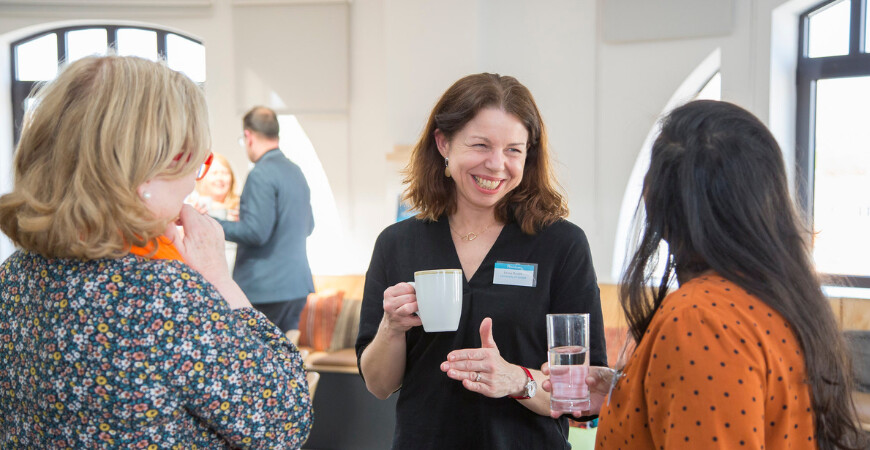

Mon 29 / 04 / 24
Three top tips for successful and impactful introductions
Referring and connecting others is a cornerstone of good networking - but as Amy Lishman has learnt over the years at Brighton Chamber, there's an art to making successful and impactful introductions. She shares her three top tips on making thoughtful introductions that create long-lasting relationships.
By Amy Lishman of Brighton Chamber
If you’re part of a business community like Brighton Chamber, it means you’re the type of person who wants to help others build their business network - making introductions between people you’ve met so that they can grow their business and network.
After all, referring and connecting others is a cornerstone of good networking, and making introductions between people in your network is a great habit to get into. It helps you build your personal brand as someone who’s generous, thoughtful and helpful - and it’s more likely that people will refer you as a result of that too.
People make introductions on email between contacts in their network for so many different reasons. You might think two people would make a great collaborative partnership – for example, a copywriter and a brand designer. Or, you may know someone in your network who could offer some insight and advice. You may think that someone offers exactly what someone needs right now. Whatever your reason, email introductions are the key to great networking.
But, not all email introductions are created equal.
If they’re not done considerately and thoughtfully, email introductions can be ineffective, a waste of your time, and a missed opportunity for the people you’re introducing. What do I mean by that?
Well. If you’re networking regularly, you’ve probably experienced a poor introduction before. The email introduction from someone you know, that pops into your inbox when you’re short of time. No heads up, just out of the blue. It’s just a couple of lines long:
‘Hi John, meet Frida. I spoke to Frida at a networking event last week and recommended she speak with you’
It has limited context, no links or information to help you understand why you’re being introduced, who you’re being introduced to, or how urgent a response is. This well-intentioned introduction has started off as more of a challenge than an opportunity for you and therefore doesn’t quite get the traction it deserves.
As Head of Member Engagement and Deputy CEO at Brighton Chamber, making introductions and bringing people together is what I do, day in, day out. Over the years, I’ve learnt there is an art to how you make an introduction. With this in mind, whether you’re at the start of your networking journey, or you’ve been doing it for years, here are my three top tips to help you make successful, impactful and thoughtful introductions.
1. Be clear on your why
If someone has asked you to make an introduction for them, make sure you ask them ‘what for?’ Ask the person requesting an introduction to send you some useful information about what they’d like to talk about, that you can use to pitch your request at the right level and about the right thing. More often than not, a request for an introduction is just a guise for a sales pitch, so this can filter out those who believe in building relationships from those who are transactional.
If you’re thinking of making an email introduction between two people in your network, because you believe that they can help each other, the same principle applies. Why are you making the introduction? Clearly articulating what you think the two people will get from the connection will build credibility and set the foundation for a much better chance of a reply.
Most people who are part of a network like the Chamber, and who are active and engaged and want to be part of the business community, are open to meeting interesting, curious people and having a good conversation. But no-one likes a sales pitch, so encouraging people to build connections and meet each other for an informal, get to know each other chat is a much more beneficial approach.
2. Right time, right introduction?
This is the most overlooked part of making an email introduction, but I think it’s the most fundamental. If you’re going to make an introduction and share emails, always check in beforehand with both parties about whether it’s the right time to make the email intro, and whether they’re happy for it to happen. By checking an introduction is welcome – either requested from someone, or you’re suggesting it – you’re setting the foundations for a more useful connection.
A quick email to ask whether the introduction is welcome is courteous, creates buy in and trust, and in the long term, gives the introduction a higher chance of resulting in a call or a meeting.
You’re also finding out whether they’re on holiday, or off sick - so you can make a better introduction when they’re back at their desk and avoid the dreaded tumbleweed of an unanswered email.
3. Build trust and credibility
Include links to each person’s website or LinkedIn profile (or both!) so that you can have a good look at who you’re being introduced to and clearly explain why you’re introducing them to each other – what’s your reason for putting them in touch?
By giving the two parties as much information as possible, you’re helping them make an informed decision about how best to move forward. You’re outlining why you think the connection is a good one, and therefore creating a more equal partnership where both parties feel they’re going to get something useful from the connection. This all-builds trust, credibility and creates the foundations for a more powerful ongoing relationship.
So, my advice is to make sure you’re clear on why you’re introducing people in the first place and make sure it’s beneficial to both parties; check it’s welcome and the right time for the introduction; and then shower them with as much information about each other as possible. Your network will evolve and grow!
Last year, the Chamber team made over 500 introductions between businesses in our network, and we have invested in some brilliant software, Heythere, designed by member Bounce Technologies to help us make more efficient and effective introductions between members. It’s been a gamechanger.
Amy Lishman is Head of Member Engagement and Deputy CEO at Brighton Chamber.
For events to connect and build your network with our thriving business community, head over to our events calendar. And, sign up for our emails to get the latest Chamber events, business support, and city updates, straight to your inbox.
Photo by Beth Wild.
If you want to contribute to the Chamber blog, contact us on hannah@brightonchamber.co.uk



